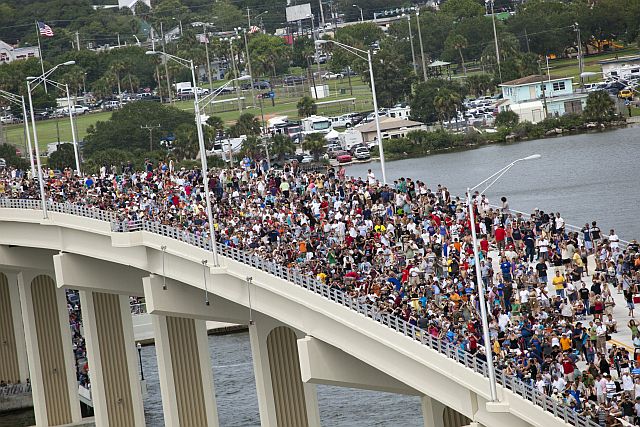
Jon Gonzales’ experiences highlight a few good reasons why college students and future STEM professionals should embark on a unique internship experience before they graduate.
With a research focus on dynamics and control for automotive systems, Gonzales’ first internship allowed him to spend time working at NASA Johnson Space Center in Clear Lake, TX.
“The idea of space fascinated me ever since I was a child,” he told Hispanic Engineer magazine while a graduate student in the mechanical engineering department at the University of California at Berkeley. “I found the engineering feats at NASA inspiring; they were literally reaching for the stars. I wanted to join the team of scientists and engineers working to design that technology.”
Gonzales spent 10 weeks at the Johnson Space Center within the Thermal Control Division testing technologies that regulate internal temperatures of various spacecraft.
Perhaps one of the least considered benefits of completing an internship is the opportunity to network and create relationships. Gonzales saw how rewarding that could be when, because of an acquaintance he met during his time at NASA, he got a chance to witness a piece of American history.
“Without a doubt, my most memorable experience happened when NASA launched its final mission of the shuttle program, STS-135, to deliver cargo to the ISS. By pure coincidence, I had learned a few days before the launch that my landlord, Ron Spencer, worked at NASA as a flight director. (Photo credit: NASA – STS-135: The Final Voyage)
“He is one of a select few people who managed operations on the International Space Station (ISS) and communicated with astronauts throughout their missions,” Gonzales added. “He was not assigned to lead for that last mission, but he had exclusive access to the viewing room behind the Mission Control room, which was full of journalists and government officials.
“My friend, whom I invited, and I were the only interns in the room. Not only that, but after the launch, he took us into the actual Mission Control room, which even journalists could not enter without authorization. Needless to say, I felt very privileged to witness a historic final mission for the NASA shuttle program.”
Two years later, Gonzales spent 10 weeks at the Samsung R&D headquarters within the electronics appliances division.
At Samsung, he researched and worked on novel designs for refrigerator compartments to enhance food preservation.
“Samsung has had a huge influence in the domain of mobile communication and household appliances,” Gonzales said. “I wanted to broaden my scope and intern in the private sector since all my past experience had mostly been focused on research at school or a governmental organization like NASA.
“Additionally, Samsung’s R&D operated from their headquarters in Suwon, South Korea; I thought it would be beneficial to gain experience interning internationally, with a different work environment and work culture from that of the U.S.,” he said.
Gonzales suggests that students apply for internships as early as possible. To be fully prepared for applying to internships, it is a good idea for students to have all career-related documents.
“I recall the NASA application requiring documents, like a resume, letters of recommendation, an essay, and college transcript,” Gonzales explained. “There was also a phone interview if the applicant made it past the screen round. I submitted only three documents for the Samsung internship: my resume, transcript, and a one-page cover letter. I spent a good amount of time preparing my applications.
“Again, it’s best to start early, especially if recommendation letters are required,” he said.
Becoming an intern opens up doors to new work environments and careers after graduation.
“For the first couple of days at NASA, all the interns participated in training sessions and social events to best prepare us for our time at NASA. After training, I worked on two separate projects, both relating to testing thermal control technologies.
“On a typical day, I would go to the office around 9 a.m., check and respond to emails, then either read and write short reports or work on developing a test set-up. Every so often, I would go to major lab facilities to run tests with large equipment and spend a large part of my day there. I got a preview of what a full-time professional job would be like: the meetings, reports, training sessions, and so on.
“I learned how to communicate my work more clearly in person and on paper and coordinate my time to meet deadlines for deliverables.
“At Samsung, I worked on new designs for a refrigerator, so I often spent time shadowing people and learning much about the design process (e.g., product specifications, geometric considerations, mechanism selection, hand-drawn sketches, CAD models, etc.).
“On a typical day, I would get to work by 9 a.m., check and respond to emails, and work the rest of the day either brainstorming designs using pencil and paper, creating CAD drawings using software, or fabricating a prototype to test a design.
“While at Samsung, I learned to adapt to change. I worked in a country with a different language, culture, cuisine, and social norms. After the experience, I am now more comfortable and adept at interacting with international colleagues.”
“Both NASA and Samsung challenged me professionally and personally,” he said.
“At NASA, I learned useful technical skills, enlarged my professional network, and improved my communication skills. At Samsung, I learned how to adapt to a new working environment and interact with international colleagues.
“I highly recommend that students intern during college. Internships not only strengthen your resume for later full-time employment opportunities but they also offer a chance to grow personally by adapting to change and working with others.”
The U.S. Army Corps of Engineers has been tasked with…
Brown and Caldwell, a leading environmental engineering and construction firm,…
Humboldt State University, one of four campuses within the California…